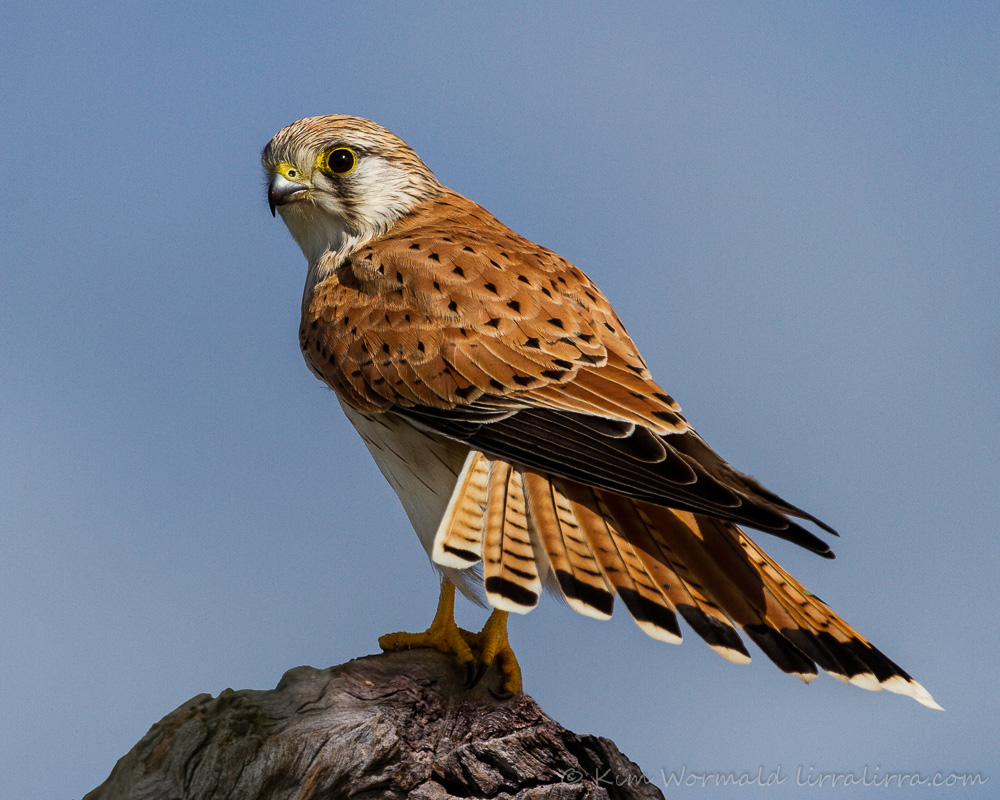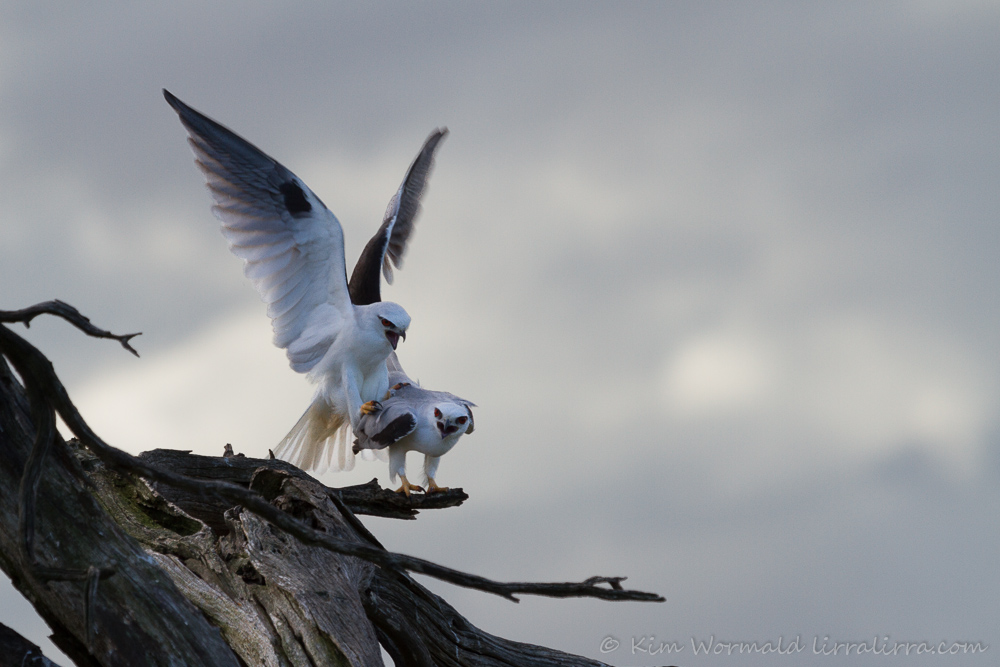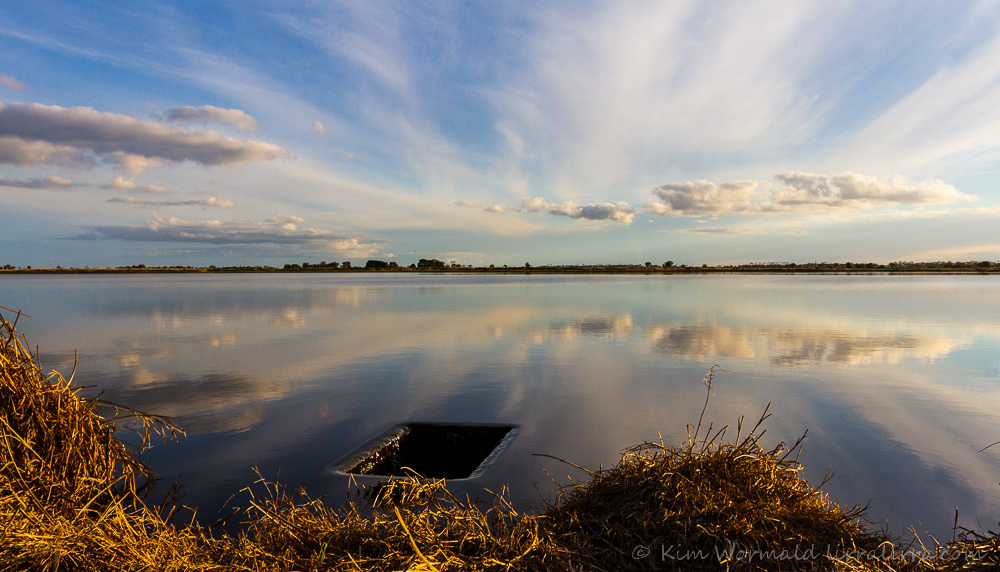Possibly the strangest thing about birders is how much we like sewage farms; there’s nothing like a trip to the poop ponds to bring a smile to my face.
The Western Treatment Plant in Werribee treats just over 50% of the sewage generated by Melbournians and common sense says it’s a place to avoid like the plague but really it’s one of the best birding locations in Australia; I applied for a permit immediately after my first visit. Last week a friend and I made a spur-of-the-moment trip, the migratory waders hadn’t returned but we saw about 50 bird species during the afternoon. We were greeted at the gate by Flame Robins, teased by Golden-headed Cisticolas in beautiful light but too distant for my lens, we watched comical Black-tailed Native-hens darting across a ford, saw numerous waterbirds and were treated to many sightings of raptors including Nankeen Kestrels, Australian Black-shouldered Kites, Whistling Kite, Little Eagle, Brown Falcon, Swamp Harrier and Spotted Harrier.
The Nankeen Kestrel looked stunning with the late afternoon sunlight accentuating its rufous feathers and the yellow of its eye-ring, cere and legs. I like the heart-shaped black patches and delicate fringing on its feathers and the obvious strength of its feet. Kestrels eat insects, reptiles, small mammals and small birds. They hunt from perches, or by hovering and dropping down in stages to capture prey, which they sometimes eat on the wing.
 Nankeen Kestrel (Falco cenchroides)Nankeen Kestrel (Falco cenchroides)
Nankeen Kestrel (Falco cenchroides)Nankeen Kestrel (Falco cenchroides)
Canon 7D, 100-400mm L IS USM, 1/640, f/7.1, 1/3 EV, ISO 100, focal length 400mm
Kestrels are well-known for the way they fan their tails to control their position when hovering. The dark band at the end of the tail is a helpful diagnostic in the field. A little of the kestrel’s streaked underparts are visible in this shot.
 Black-shouldered Kite (Elanus axillaris)
Black-shouldered Kite (Elanus axillaris)
Canon 7D, 100-400mm L IS USM, 1/400, f/8, ISO 200, focal length 370mm
Spring has sprung! These Black-shouldered Kites were perched on opposite ends of a gnarled tree and I was wondering which was male and which female when they answered my question. The stormy liaison was over in a moment and hopefully there will be between two and five red-eyed, yellow-legged hatchlings in the coming weeks.
 Overflow at the Western Treatment Plant, Werribee
Overflow at the Western Treatment Plant, Werribee
Canon 7D, EF 17-40mm, 1/800, f/5.6, ISO 200, focal length 17mm
The sun was low in the sky and we were supposed to have left for home an hour earlier when my friend detoured along a track to show me this overflow drain. He kindly loaned me his wide-angle lens and I knelt at the edge of the lagoon to take this otherworldly image. I like the way the clouds seem to point to the drain, emphasising how mysterious it looks, and the lighting was just lovely.
As I was creating this post I found myself singing John Denver’s “Some days are diamonds, some days are stone …” then, being a birder, the diamonds became Diamond Firetails and Doves, and the stones became Bush Stone-curlews. Now I’m inventing lyrics: “Some days are tropicbirds, some days are gulls; some days are eagles, some days are crows …’ ♪ ♫ ♩ ♬
Happy birding, Kim
NB It is possible to receive a weekly email letting you know that lirralirra has been updated – just add your address to the ‘Subscribe to email’ box above right.
Also, I recently added a Facebook ‘like’ button. Thank you to all ‘likers’ – I like you too!

Hi Kim,
I recently bought a 6D to compliment my 7D. perhaps one day I might have the enjoyment of a 400mm, in the meanwhile I will
enjoy seeing your excellent images
Hi Ray, thanks for your lovely comment. You create magical images with your current gear!
You asked what the word “crécerelle’ means.
A cérelle is a “Reel of wood that makes a rasping noise” like the Kestrel has a rasping voice.
The use of the “rattle” was reserved for the lepers to warn their way. The Church used it as replacement for the bells on Good Friday. Later it became a toy for children.
So the translation means: Rasping voice.
Hope that helps?
Love your photos, only came here by accident. Will be back. Cheers Marie-Louise
Thank you Marie-Louise, that helps a lot. I’m glad you enjoyed your visit.
Hi there – wonderful set of pictures. Werribee is great place – for that last 8 (or so years) I have spent some time down there between Christmas and New Year banding the waders – some people stay for a couple of days, others just a morning. If you have any interest in being involved I can put you in touch with the organisers.
Cheers – Stewart M – Melbourne
Hi Stewart, we’ll have a housefull of guests betweem Christmas and New Year but I’d love to be involved with the waders. Could you email me about it? Thank you!
Love the kestrel and the Kite shot, awesome birds. And the last sky shot is gorgeous! Great series! Enjoy your weekend!
Thank you Eileen, so glad you enjoyed the images. You have a lovely weekend too!
hi kim
happy to see krestrel from your area, very close from european krestrel ;))) and nice portrait too
the coupling of the Black-shouldered Kite is a wonderfull moment you have catched, not so easy to do, you should be very exited to have seen this, i can imagine it =)))
have a nice day and happy birding kim ☺
Hi Eric, they are very similar, beautiful birds. I’ve just found out that ‘kestrel’ comes from the French word ‘crecerelle’ – do you know if that’s true, and if so, what ‘crecerelle’ means?
I’m also a fan of the fan … and I like your lyrics.
Hi Dave, now you’ve got me imagining a parody of the entire song: “Sometimes the magpies won’t leave me alone” … I think I’ll work on it!
Nice ones Kim, good use of light. I can see you getting better day by day, way to go 🙂
Thank you Bharath, I appreciate your comments very much.
Love the fan of the kestrel’s tail! Your landscape picture is great too
That makes you a fan of the fan 😉 I love them too. I’m generally hopeless with landscapes so I’m really glad you like it.
It’s Friday which means more gorgeous photos from Kim!
Thank you
Alison
What a beautiful thing to say Alison, thank you!
Beyond beautiful. Thank you.
I’m so pleased that you liked the images, you are very welcome, thank you for commenting.
Brilliant photos, Kim.
Love them all…
Thank you so much Carole for your lovely comment, it’s really lovely to know 🙂